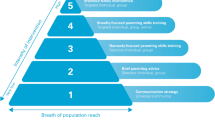Abstract
A population-level approach to deliver parenting and family support is a necessary but neglected approach needed to reduce the high prevalence of emotional/behavioral problems in children, decrease inadequate and potentially abusive parenting practices, and to provide improved parenting support to all parents within a specified population. We examined the initial feasibility of a large-scale professional training regimen to prepare existing service providers to implement an evidence-based preventive intervention in the realm of parenting and family support. Data from the U.S. Triple P System Population Trial are used to illustrate how a parenting and family support intervention can be successfully disseminated to a large, multidisciplinary workforce. We discuss lessons learned from this dissemination effort as well as implications for population-based approaches to child and family well-being.
Similar content being viewed by others
References
Connor-Smith, J. K., & Weisz, J. R. (2003). Applying treatment outcome research in clinical practice: Techniques for adapting interventions to the real world. Child and Adolescent Mental Health, 8, 3–10.
Costello, E. J., Keeler, G. P., & Angold, A. (2001). Poverty, race/ethnicity, and psychiatric disorder: A study of rural children. American Journal of Public Health, 91, 1494–1498.
Elliott, D. S., & Mihalic, S. (2004). Issues in disseminating and replicating effective prevention programs. Prevention Science, 5, 47–53.
Egger, H. L., & Angold, A. (2006). Common emotional and behavioral disorders in preschool children: Presentation, nosology, and epidemiology. Journal of Child Psychology and Psychiatry, 47, 313–337.
Flay, B. R., Biglan, A., Boruch, R., Gonzalez Castro, F., Gottfredson, I., Kellam, S., Moscicki, E., Schinke, S., Valentine, J. C., & Ji, P. (2005). Standards of evidence: Criteria for efficacy, effectiveness, and dissemination. Prevention Science, 6, 151–175.
Greenhalgh, T., Robert, G., Macfarlane, F., Bate, P., & Kyriakidou, O. (2004). Diffusion of innovations in service organizations: Systematic review and recommendations. The Milbank Quarterly, 82, 581–629.
McGimsey, J., Greene, B., & Lutzker, J. (1995). Competence in aspects of behavioral treatment and consultation: Implications for service delivery and graduate training. Journal of Applied Behavior Analysis, 28, 301–315.
McMahon, R. J., & Estes. A. M. (1997). Conduct problems. In E. J. Mash & L. G. Terdal (Eds.), Assessment of childhood disorders (3rd ed., pp. 130–193). New York: Guilford Press.
Melton, G. B. (2005). Mandated reporting: A policy without reason. Child Abuse and Neglect, 29, 9–18.
Regalado, M., & Halfon, N. (2002). Primary care services: Promoting optimal child development from birth to three years. The Commonwealth Fund.
Sanders, M. R. (1999). Triple P Positive Parenting Program: Towards and empirically validated multilevel parenting and family support strategy for the prevention of behavioral and emotional problems in children. Clinical Child and Family Psychology Review, 2, 71–90.
Sanders, M. R., Cann, W., & Markie-Dadds, C. (2003a). Why a universal population-level approach to the prevention of child abuse is necessary. Child Abuse Review, 12, 145–154.
Sanders, M. R., Murphy-Brennan, M., & McAuliffe C. (2003b). The development, evaluation and dissemination of a training programme for general practitioners in evidence-based parent consultation skills. International Journal of Mental Health Promotion, 5, 13–20.
Sanders, M. R., Tully, L. A., Turner, K. M. T., Maher, C., & McAuliffe, C. (2003). Training gp’s in parent consultation skills-an evaluation of training for the Triple P-Positive Parenting Program. Australian Family Physician, 32, 763–768.
Sanders, M. R., & Turner, K. M. T. (2005). Reflections on the challenge of effective dissemination of behavioral family intervention: Our experience with the triple p-positive parenting program. Child and Adolescent Mental Health, 10, 158–169.
Sanders, M. R., Turner, K. M. T., & Markie Dadds, C. (2002). The development and dissemination of the Triple P Positive Parenting Program: A multilevel, evidence-based system of parenting and family support. Prevention Science, 3, 173–189.
Taylor, T. K., & Biglan, A. (1998). Behavioral family interventions for improving child-rearing: A review of the literature for clinicians and policy makers. Clinical Child and Family Psychology Review, 1, 41–60.
Turner, K. M. T., Nicholson, J. M., & Sanders, M. R. Influence of self-efficacy and training, program, and workplace factors on the implementation of behavioral family intervention in primary care, under review.
Turner, K. M. T., & Sanders, M. R. (2006). Dissemination of evidence-based parenting and family support strategies: Learning from the triple p-positive parenting program system approach. Aggression and Violent Behavior, 11, 176–193.
U.S. Department of Health and Human Services, Administration on Children, Youth and Families. Child Maltreatment 2004. Washington, DC: U.S. Government Printing Office, 2006. Retrieved August 8, 2006, from http://www.acf.dhhs.gov/programs/cb/pubs/cm04/chapterthree.htm#age
Weisz, J. R., Jensen, A. L., & McLeod, B. D. (2005). Development and dissemination of child and adolescent psychotherapies: Milestones, methods, and a new deployment-focused model. In E. Hibbs & P. Jensen (Eds.), Psychosocial treatments for child and adolescent disorders: Empirically based strategies for clinical practice (2nd ed., pp. 9–39). Washington: APA.
Acknowledgement
This research was supported by grant funding (U17/CCU422317) from the National Center for Injury Prevention and Control, Centers for Disease Control and Prevention.
Author information
Authors and Affiliations
Corresponding author
Rights and permissions
About this article
Cite this article
Shapiro, C.J., Prinz, R.J. & Sanders, M.R. Population-Wide Parenting Intervention Training: Initial Feasibility. J Child Fam Stud 17, 457–466 (2008). https://doi.org/10.1007/s10826-007-9167-9
Published:
Issue Date:
DOI: https://doi.org/10.1007/s10826-007-9167-9




